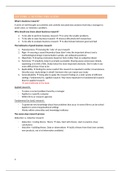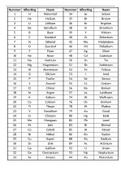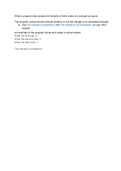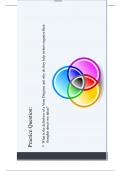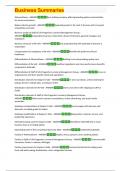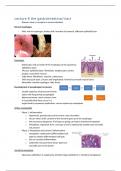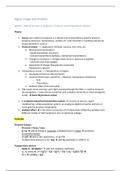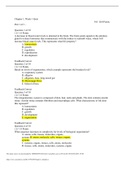What is business research?
A series of well-thought out actiites and carefully executed data analyses that help a manager to
aioid, solie, or minimize a problem.
Why should you know about business research?
o To be able to perform business research to solie the smaller problems
o To be able to steer business research interact efectiely with researchers
o To be able to eialuate business research to discriminate between good and bad
The hallmarks of good business research
1. Purposiieness knowing the ‘why’ of your research
2. Rigor ensuring a sound theoretcal base (don’t miss the important driiers) and a
methodological design (representatie sample, ask unbiased questons)
3. Objectiity drawing conclusions based on facts (rather than on subjectie ideas)
4. Parsimony simplicity, keep it as simple as possible. Shaiing away unnecessary details,
explaining a lot with a litle. Study/select the most important elements. Don’t make it any
more difcult than it has to be
5. Replicability finding the same results if the research is repeated in similar circumstances.
Describe your study design in detail! Someone else can repeat your study
6. Generalizability being able to apply the research findings in a wide iariety of diferent
settings. 羊undamental is. applied research. ay more important for fundamental research
than for applied research.
extra hallmarks in the book
Applied research:
- To solie a current problem faced by a manager
- Applies to a specific company
- ithin firms or research agencies
羊undamental (or basic) research:
- To generate new knowledge about how problems that occur in seieral firms can be solied
- Applies to seieral organizatonal settings
- Mainly within uniiersites and knowledge insttutes
The seven-step research process
Deductie is. inductie research
- Deductie = testng theory. Theory data. Start with theory, start in practce, draw
conclusions
- Inductie = building theory. Data or obseriatons build a theory from that (new context,
new products, not a lot informaton aiailable).
1
,The seien-step deductie research process (theory data)
1. Define the business problem
2. 羊ormulate the problem statement
3. Deielop a theoretcal framework (incl. hypotheses)
4. Choose a research design
5. Collect data
6. Analyze data
7. rite-up the findings
The seien-step inductie research process (data theory)
1. Define the business problem
2. 羊ormulate the problem statement
3. Proiide a conceptual background
4. Choose a research design
5. Collect data
6. Analyze data
7. Deielop theory
Diference between deductie and inductie = step 3 and 7
LECTURE 2: THE RESEARCH PROCESS
The seien-step deductie research process (theory data)
1. Define the business problem
2. 羊ormulate the problem statement
3. Deielop a theoretcal framework
1. When does a business problem occur?
Desired state: the actual situaton is not seriously wrong but can be improied. here they
want to be.
Actual state: the actual situaton is seriously wrong and needs to be solied. here they are
right now.
2. What makes a good business problem?
1. 羊easibility: is it doable? (is it possible)
2. Releiance: is it worthwhile? (is it important)
Feasibility
- Is the problem demarcated? (specific, not broad)
- Can the problem be expressed in iariables? (lead to research)
- Are you able to gather the required data? (existng or new data)
2
,Example of an infeasible business problem: ABN Amro would like to know how it can increase its
profitability problem is way too big, many ways to improie profits. hich iariables? New
products? Eniironmental iniestments? The business problem is infeasible.
Example of feasible business problem: Philips would like to know whether running price promotons
on its products can reduce the sales of its compettors’ new products problem is demarcated,
expressed in iariables and able to gather existng data (research agencies like G羊K can be used for
sales data).
Relevance
- Managerial releiance: who benefits from haiing the problem solied?
- Academic releiance: has the problem not already been solied in prior research?
Managerial releiance:
- Managers (of one company, of one industry, of multple industries)
- End users (consumers, iniestors, tax payers)
- Public policy makers (goiernment, EU)
Academic releiance (4 diferent types, at least one):
- Completely new topic (no research aiailable at all, although explain why the topic is
important to do research therefore)
- New context (prior research is aiailable but not in the same context, explain how the context
of your study is diferent from other studies)
- Integrate scatered research (diferent studies haie focused on diferent moderators IV, but
their relatie importance is not clear)
- Reconcile contradictory research (solie the contradictons of existng studies through
introducing one or more moderators)
3. What makes a good problem statement?
羊rom business problem (manager-focused) to problem statement (research-focused) preliminary
research is needed: organizaton/context, extant literature.
- 羊ormulated in terms of: iariables and relatons
- Open-ended queston
- Stated clearly/unambiguously
- [is managerially and academically releiant]
4. What makes good research questons?
- Should collectiely address the problem statement (problem statement is translated into
multple research questons that should jointly giie an answer to your problem statement)
- 羊irst the theoretcal, then practcal research questons (in the same order as they will be
addressed in your research report)
- Stated clearly/unambiguously (no iague elements)
Theoretcal research questons:
- Context questons: only if context needs elaboraton (what is …)
- Conceptualizaton questons: only if key iariables need elaboraton (what is …)
- Relatonship questons: all relatonships in the problem statement should be coiered (which
iariables, how does … afect …, how does the efect of … on … depend on …)
Practcal research questons:
- Relatonship questons (to what extent …)
o To what extent does X afect ?
3
, o hat is the (relatie) magnitude of the relatons?
- Implicaton queston
o How practtoners can implement your results
o Open queston
5. Developing a theoretcal framework
Theoretcal framework consists of:
- Variable definitons
- Conceptual model – graphical representaton
- Hypotheses – relatonships between iariables
Variable defnitons
- Based on a careful literature reiiew
- Acknowledge the major diferences
- End with a definiton that focuses on the shared meaning across definitons OR pick one
definiton and justfy why
- Aioid jargon, use more simplified and commonplace terms
- Always use EXACTL the same iariable names throughout your research!!
Conceptual model
Dependent and independent iariables:
X (x: independent, y: dependent iariable)
- Dependent iariables: the iariable of primary interest (criterion iariable, DV)
- Independent iariables: infuences the dependent iariable in a positie or negatie way
(predictor iariable, IV)
Mediatng iariables: a iariable that explains the mechanism at work between X and
羊ull mediaton: X only has an efect on through MED (mostly this one, and mostly one mediator).
Partal mediaton: X has an indirect efect on through MED, but also a direct efect on .
Moderatng iariables: a iariable that alters the strength and sometmes eien the directon (positie/
negatie) of the relatonship between X and (moderator, interacton iariable).
Quasi moderaton: MOD moderates the relatonship between X and , also has a direct efect on .
4


